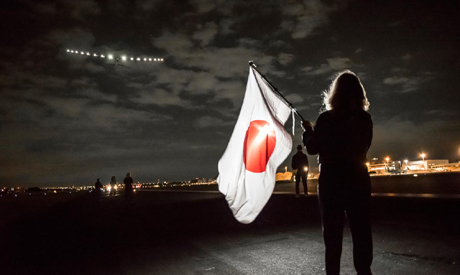
Solar Impulse 2 taking off from Nagoya Airfield on June 28. (Source: solarimpulse.com)
Solar Impulse 2, a manned aircraft powered entirely by solar energy, is currently attempting to set new benchmarks in aviation history by crossing the Pacific Ocean. The plane took off from Nagoya, Japan at 18:03 GMT on Sunday and is expected to land in Hawaii in approximately four days, according to the project's website.
This would be the longest flight by any manned solar aircraft, both in terms of distance and of duration. After a break in Hawaii, it will take the plane another four days to reach the western coast of the United States.
Solar Impulse 2 aims at completing a round-the-world trip in order to demonstrate the potential of renewable energies. It would be the first of any solar-powered airplane. Its wings are covered in solar cells that power the plane during the day, as well as simultaneously charging batteries that allow the plane to fly at night. The range of the plane is thus practically limitless, only restrained by the endurance of the pilot.
Feeling a bit lonely up there, but very excited about the rest of this flight, the moment of truth! pic.twitter.com/w3whafms2G
— André Borschberg (@andreborschberg) June 29, 2015
Its journey started in Abu Dhabi on March 9, and it has already halted in Oman, India, Myanmar and China. The plane made a first attempt at reaching Hawaii from Nanjing, China, on May 30, but it had to be redirected to Nagoya because of bad weather.
The team behind the aircraft has been patiently awaiting a good weather window ever since. After a false start last Tuesday, a further window presented itself yesterday and the team decided to seize the occasion. The project leaders confirmed on Facebook that the plane had passed the point of no return early this morning (03:17 UTC) and was underway on its leg to Hawaii.
The current flight is the fruit of many years of hard work. The Solar Impulse project was first launched in 2003 by two experienced Swiss pilots, André Borschberg and Bertrand Piccard. Their first prototype plane, Solar Impulse 1, completed the world's first manned overnight solar flight in 2010, and the project has so far set more than eight world records for solar aviation. Both pilots are taking turns piloting Solar Impulse 2, and Borschberg got the task of manning the current flight to Hawaii.
The point of no return for this flight to Hawaii was also the point of no return for the entire project pic.twitter.com/w6onvdiVUg
— Bertrand PICCARD (@bertrandpiccard) June 29, 2015
Even with these records, the Pacific crossing will be a challenge for the team. Solar Impulse's longest flight so far was the 44-hour crossing from Nanjing to Nagoya, now pilot André Borschberg must face about 120 hours in a cockpit the size of a phone booth, according to the BBC. He can only rest for 20 minutes at a time, though he has practiced meditation and yoga to help him save energy during the flight, the BBC reports.
Changing weather conditions might also be a challenge. "Up until now, Solar Impulse always flew above the ground, in a controlled airspace, a protected environment", Bertrand Piccard tweeted this morning, stressing how groundbreaking this trip is not only for onlookers, but also for the team itself.
Borschberg is prepared for any eventuality, however, and the plane is equipped with an inflatable boat and supplies for several days in case he would be forced to ditch the plane into the ocean, the BBC writes. The team naturally hopes that none of it will be necessary and that Borschberg will safely touchdown in Hawaii later this week.
Short link: